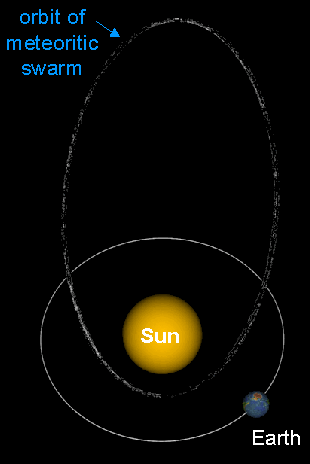|
S c i e n c e
If you spend any reasonable amount of time looking up at the night sky, you've
probably seen a "shooting star". Shooting stars are actually not stars at all, but are
meteors, which is a light phenomenon that occurs when tiny grains from space
burn up as they enter the Earth's upper atmosphere.
You will be able to see a meteor if any interplanetary grain greater than about a few millimetres in size hits the Earth's atmosphere at a speed greater than about 10 km/s. Once the grains
(more commonly referred to as a meteoroid in the astronomy trade) are about 100 km from the Earth's surface, the friction from the Earth's atmosphere heats the meteoroid and atoms on the outer surface are ablated. These ablated atoms continue to collides with atmospheric atoms, which become excited and ionized. A train several kilometres long of ionised and glowing atmospheric gas is seen in the sky as a "shooting star" or meteor. By the time the meteoroid is about 80 km from the Earth's surface, it will have totally evaporated. (Larger meteoroids that survive their passage
through the atmosphere and land on the Earth's surface are called meteorites.)
The brightness and the length of meteors depends on how fast the meteoroid is travelling and at what angle it strikes the Earth's upper atmosphere.
|
So where do all these dust grains come from? Some are leftover bits of junk from the
formation o the Solar System, others are bits of rock that are ejected into space during collisions between asteroids and meteorites, and others still are grains from evaporated comets.
Comets are frozen bodies made of loosely bound chunks of rock and ice which orbit the Sun. When comets approaches the Sun in their orbits, the ice evaporates and some of the dust is released. Eventually the entire comet will evaporate, and as it does so it leaves behind a meteoritic swarm. The small chunks of dust that make up the meteoritic swarm continue to orbit the Sun and over time, the meteoroids spread themselves completely over the original comet's orbit.
When the Earth's orbit crosses the path of the meteoritic swarm of an existing or burnt
out comet, we experience meteor showers.
The meteoroids in cometary orbits are all travelling in parallel orbits and so they seem to be coming from the same point in space, called the radiant.
The Leonids meteors - called Leonids because the radiant is in the directions of the constellation of Leo - are dust particles from the Temple-Tuttle comet, which orbits the Sun every 33 years. The orbital path of Temple-Tuttle takes it out to the orbit of Uranus. The Earth's orbit carries it through the Temple-Tuttle meteoritic swarm on November 17 and 18 each year. The highest concentration of meteoroids is found just behind the comet itself, so when comet Temple-Tuttle passes closest to the Sun - which it last did in 1998 - the dust supply of the Leonids are replenished, giving rise to stronger than usual meteor showers. This year's Leonids shower is expected to be a strong one!
|

|
Sarah Maddison
Centre for Astrophysics and Supercomputing
Swinburne University of Technology
|







